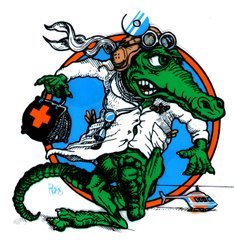Thursday, November 15, 2012
Management of Minor Head Injury in Patients Receiving Oral Anticoagulant Therapy: A Prospective Study of a 24-Hour Observation Protocol
Management of Minor Head Injury in Patients Receiving OralAnticoagulant Therapy: A Prospective Study of a 24-HourObservation Protocol
Background
The indications for computed tomography (CT) scanning in
the setting of minor head injury have been the focus of
substantial research. Long-term oral anticoagulation has been
identified as a significant risk factor for intracranial injury,
and CT scanning is generally recommended for such patients
regardless of clinical presentation. However, it remains
unclear whether such patients should then be hospitalized for
observation or undergo a later second CT scan. Oral
anticoagulant therapy is prescribed to prevent thromboembolic
complications of atrial fibrillation, deep venous thrombosis, and
surgically placed cardiac valves.
Thursday, October 18, 2012
Prospective Evaluation of a Clinical Practice Guideline for Diagnosis of Appendicitis in Children
Prospective Evaluation of a Clinical Practice Guideline for Diagnosis of Appendicitis in Children
Objectives:
The objective was to assess the performance of a clinical practice guideline for evaluation of possible appendicitis in children. The guideline incorporated risk stratification, staged imaging, and early surgical involvement in high-risk cases.
Objectives:
The objective was to assess the performance of a clinical practice guideline for evaluation of possible appendicitis in children. The guideline incorporated risk stratification, staged imaging, and early surgical involvement in high-risk cases.
Thursday, September 6, 2012
Patients With Rib Fractures Do Not Develop Delayed Pneumonia: A Prospective, Multicenter Cohort Study of Minor Thoracic Injury
Patients With Rib Fractures Do Not Develop Delayed Pneumonia: A Prospective, Multicenter Cohort Study of Minor Thoracic Injury
Background
In 2006, there were 119.2 million visits to hospital
emergency departments (EDs) in the United States, and
more than one third of them were injury-related. Thoracic
trauma frequency is estimated at 12 people per million per
day, representing more than 796,000 ED visits annually.
In the case of thoracic trauma, injuries of moderate
severity are most often sustained to the chest wall and thus
rarely require surgical intervention. Ziegler and Agarwal
reported a 10% incidence of rib fractures in trauma patients
treated at their site. In 2003, Liman et al observed that 2 of
3 patients could be safely discharged from EDs. As financial
pressures create more ambulatory care situations, minor
thoracic injury patients are rapidly discharged from EDs
without appropriate follow-up.
Background
In 2006, there were 119.2 million visits to hospital
emergency departments (EDs) in the United States, and
more than one third of them were injury-related. Thoracic
trauma frequency is estimated at 12 people per million per
day, representing more than 796,000 ED visits annually.
In the case of thoracic trauma, injuries of moderate
severity are most often sustained to the chest wall and thus
rarely require surgical intervention. Ziegler and Agarwal
reported a 10% incidence of rib fractures in trauma patients
treated at their site. In 2003, Liman et al observed that 2 of
3 patients could be safely discharged from EDs. As financial
pressures create more ambulatory care situations, minor
thoracic injury patients are rapidly discharged from EDs
without appropriate follow-up.
Thursday, February 9, 2012
Treating primary headaches in the ED: can droperidol regain its role?
Treating primary headaches in the ED: can droperidol regain its role?
OBJECTIVE:
The aim of this study was to describe the use and efficacy of low-dose (≤2 mg) droperidol for the treatment of primary headaches (ie, migraine, cluster, tension-type headache and trigeminal autonomic cephalalgias, and other primary headaches) in the emergency department (ED).
OBJECTIVE:
The aim of this study was to describe the use and efficacy of low-dose (≤2 mg) droperidol for the treatment of primary headaches (ie, migraine, cluster, tension-type headache and trigeminal autonomic cephalalgias, and other primary headaches) in the emergency department (ED).
Subscribe to:
Posts (Atom)
